 On 21 March, 1978 the Cryonics Institute (CI) acquired their first facility, a storefront building in the Detroit Metro area. The CI building was the first wholly owned (cash purchase) patient storage facility in the history of cryonics, and remains one of only two in the world today. The May, 1978 issue of the Immortalist Society newsletter, The Immortalist, described the facility thusly:
On 21 March, 1978 the Cryonics Institute (CI) acquired their first facility, a storefront building in the Detroit Metro area. The CI building was the first wholly owned (cash purchase) patient storage facility in the history of cryonics, and remains one of only two in the world today. The May, 1978 issue of the Immortalist Society newsletter, The Immortalist, described the facility thusly:
“The place has three rooms, two lavatories is air conditioned and has a gas-fired furnace and hot water heater. The building is in very good condition and modern in appearance with wood paneled interior walls, and acoustical ceilings. The exterior is brick. “[1]
As was the case with all cryonics organizations’ initial facilities, the CI facility was small and cramped. It also lacked the ceiling height necessary for upright (open at the top) cryostats and this limitation was an additional impetus for CI to develop the fiberglass-epoxy resin type of cryostat (using perlite and low vacuum insulation) that they currently use to store their patients. The socioeconomic meltdown of the Detroit Metro area was well underway in 1978, and the CI facility was not located in a desirable area of the city. Few photos of the first CI facility were ever published; one being a photo that appeared on the cover of The Immortalist in June of 1978.[2] The purchase price of the first CI facility was rumored to be in the range of $10,000 to $15,000.
The exterior photos of that first CI facility (below) were taken by the author in January of 1987.
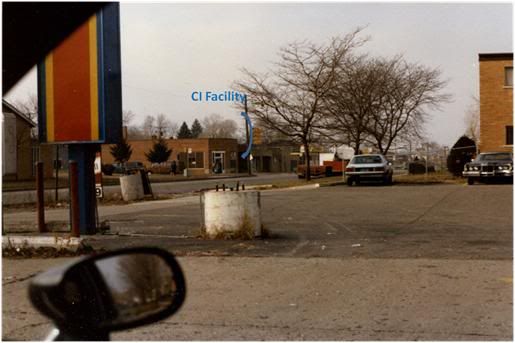 Above: The CI facility as seen from the street corner a block away in Detroit Michigan.
Above: The CI facility as seen from the street corner a block away in Detroit Michigan.
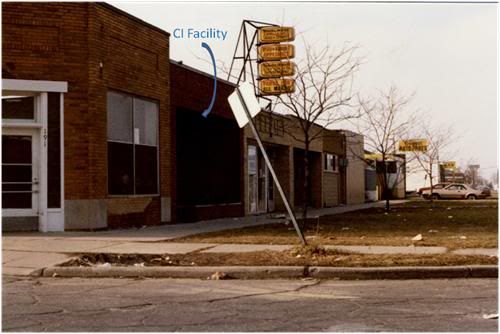 Above: The first CI facility was quite small and was tucked in between other businesses in a residential area of Detroit.
Above: The first CI facility was quite small and was tucked in between other businesses in a residential area of Detroit.
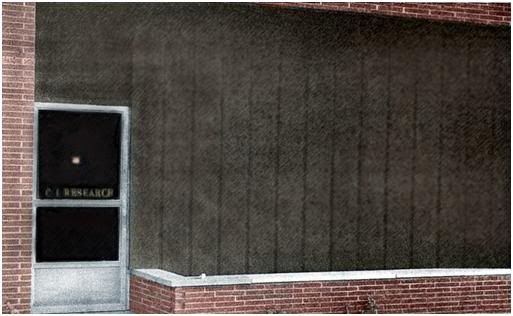 Above: The entrance to the CI facility in 1978.
Above: The entrance to the CI facility in 1978.
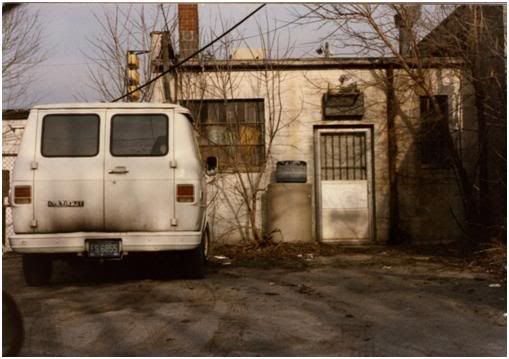 Above: The rear of the CI facility in 1978.
Above: The rear of the CI facility in 1978.
 Above: CI’s first cryostat. This cryostat was fabricated in CI’s first facility by Andy Zawacki and Robert Ettinger, and was later transported to their second, much larger facility in Clinton Township (see below). Photo by Taryn Simon, 2008.
Above: CI’s first cryostat. This cryostat was fabricated in CI’s first facility by Andy Zawacki and Robert Ettinger, and was later transported to their second, much larger facility in Clinton Township (see below). Photo by Taryn Simon, 2008.
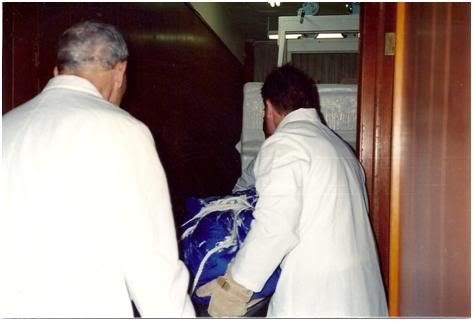 Above and below: American Cryonics Society (ACS) patient being readied for cool-down to liquid nitrogen temperature. Control of temperature descent was by slowly lowering the patient towards a pool of liquid nitrogen in the bottom of rectangular, vacuum insulated fiberglass and epoxy resin cryostat. Above, Robert Ettinger (left) and Andy Zawacki (right) and below. Robert Ettinger (far right) and Andy Zawacki (right). Photos by Jim Yount.
Above and below: American Cryonics Society (ACS) patient being readied for cool-down to liquid nitrogen temperature. Control of temperature descent was by slowly lowering the patient towards a pool of liquid nitrogen in the bottom of rectangular, vacuum insulated fiberglass and epoxy resin cryostat. Above, Robert Ettinger (left) and Andy Zawacki (right) and below. Robert Ettinger (far right) and Andy Zawacki (right). Photos by Jim Yount.
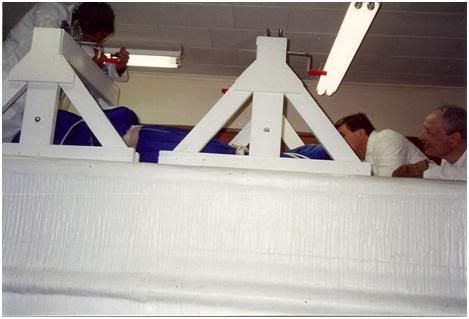
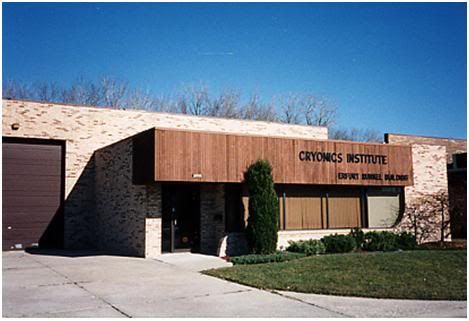
In 1994 CI acquired their current facility, the Erfurt-Runkel Building in Clinton Township (above), which is a suburb northeast of Detroit for about $300,000. The current CI facility is a spacious and attractive building filled with clinically white cryostats containing 103 human patients. The building is named after two long time CI activists and Directors, Walter Runkel and John Erfurt whose bequests funded the purchase of the Clinton Township building.
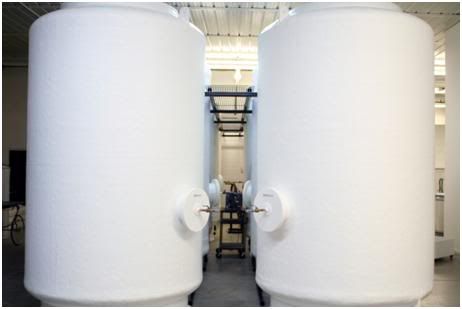
Above and below: The interior of the CI facility patient storage area in Clinton Township, MI. Photos by Murray Ballard (2009).
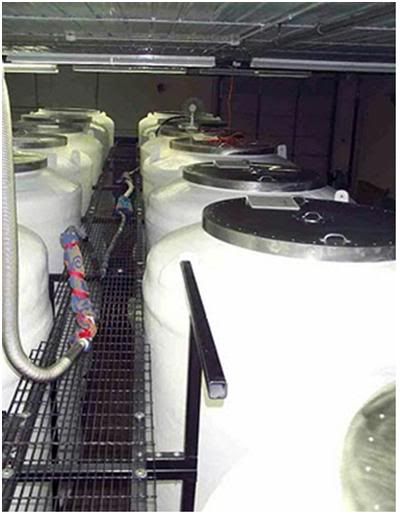
References

I just read on New Cryonet that Robert deanimated.
His book Man Into always meant a great deal to me. I hope he can live again and see how much of the “the future” he got right.
I had many differences with Bob Ettinger, and it would be hypocritical of me to say that I liked him as a person. However, he had a profound, powerful and humane idea in cryonics. He also had the courage and the persistence to doggedly pursue cryonics from the time he first promulgated the idea in 1962, until his cardiac arrest at 4PM EST today: that is 49 years of unbroken and unbowed advocacy. Not once in all those years did he ever hesitate, withdraw, reconsider, or become discouraged to the point of inaction. That is a remarkable legacy that, as far as I know, no one else in cryonics has come close to achieving.
Robert C. W. Ettinger profoundly changed my life for the better, and I would much worse than a hypocrite not to both acknowledge that, and to thank him publicly for doing so, He was thanked by me both publicly and privately on a number of occasions; and whatever our differences, my debt of genuine gratitude to him will always be there.
I was relieved to hear that his cryopreservation proceeded not just smoothly, but that it apparently went as optimally as current circumstances allow, with minimal ischemic time. I wish Bob the best possible outcome from cryopreservation and the best possible future.
In many ways Bob Ettinger was a very fortunate man. He lived to see his utterly paradigm changing idea practically implemented, and was able to have join him on his journey his wives, his mother and many of his closet friends and associates. But perhaps he was most fortunate of all in being one of a very few human beings (if any) who have faced down death absolutely certain that he had every reasonable chance of overcoming it. That is perhaps the most remarkable and satisfying achievement of all. May you live again, Bob Ettinger, and until then, rest safely and well. — Mike Darwin
I was relieved to hear that his cryopreservation proceeded not just smoothly, but that it apparently went as optimally as current circumstances allow
I am relieved to hear you report that!